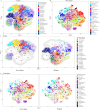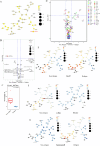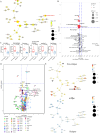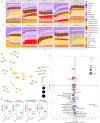Single-cell spatial proteomics of non-relapse small cell lung cancer identifies tumor microenvironment determinants of survival
- PMID: 40526293
- PMCID: PMC12174242
- DOI: 10.1007/s10565-025-10056-0
Single-cell spatial proteomics of non-relapse small cell lung cancer identifies tumor microenvironment determinants of survival
Abstract
Small cell lung cancer (SCLC) is characterized by high malignancy and early propensity for metastasis, and modest response to immunotherapy due to the immunosuppressive microenvironment. Surgical intervention has shown benefits in treating early-stage SCLC. However, most patients experience recurrence after surgery. The factors associated with relapse free survival in these patients remain unclear. We collected operation specimens from ten early-stage SCLC patients (N0M0), conducted long-term follow-up, and grouped them based on disease status. Subsequently, we performed a retrospective analysis using single-cell spatial imaging mass cytometry to explore the characteristics of tumor cells and differences in the tumor microenvironment, especially the single-cell constitute of immune cells, between the two groups. We found that, in early-stage SCLC, tumor cells display pronounced heterogeneity, both intra-group and inter-group. Patients with early recurrence are characterized by a distinct subpopulation of tumor cells with high Ki-67 expression. Non-relapse patients demonstrate better infiltration of M1 macrophages and stromal cells. Neighborhood analysis suggested that positive interactions between macrophages, stromal cells, and T cells with tumor cells may benefit patient prognosis. Additionally, recurrent tumor cells might enhance their metastatic capacity and remodel the microenvironment through upregulation of GranzymeB or reduction of c-Myc expression. In conclusion, SCLC tumor cells demonstrate tumor heterogeneity and microenvironmental changes in the early clinical stages. A higher proportion of M1 macrophages is associated with prolonged postoperative survival in early-stage SCLC patients. This research provides novel insights and evidence for treating and preventing postoperative recurrence in SCLC.
Keywords: Imaging Mass Cytometry; Immune signature; Macrophage; Small cell lung cancer; Tumor heterogeneity.
© 2025. The Author(s).
Conflict of interest statement
Declarations. Conflicts of interest: The authors have no relevant financial or non-financial interests to disclose. Competing interests: The authors declare no competing interests. Ethical approval: This study is a retrospective analysis without any intervention. All human specimens and clinical information used in this study had received approval from the Institutional Review Board (IRB) of Shanghai Chest Hospital (IS21118, approved on November 8, 2020), and was conducted in accordance with the Strengthening the Reporting of Observational Studies in Epidemiology (STROBE) guidelines.
Figures






Similar articles
-
Clinicopathological significance of cancer stem-like cell markers in high-grade neuroendocrine carcinoma of the lung.J Cancer Res Clin Oncol. 2015 Dec;141(12):2121-30. doi: 10.1007/s00432-015-1985-3. Epub 2015 May 12. J Cancer Res Clin Oncol. 2015. PMID: 25963795 Free PMC article.
-
[Joint analysis of invasive margins and tumor center to evaluate the prognostic value of bystander CD8+ T cells in early-stage non-small cell lung cancer].Zhonghua Zhong Liu Za Zhi. 2025 Jun 23;47(6):508-516. doi: 10.3760/cma.j.cn112152-20240805-00326. Zhonghua Zhong Liu Za Zhi. 2025. PMID: 40534266 Chinese.
-
Spatial multi-omics profiling of breast cancer oligo-recurrent lung metastasis.Oncogene. 2025 Jul;44(27):2268-2282. doi: 10.1038/s41388-025-03388-y. Epub 2025 Apr 15. Oncogene. 2025. PMID: 40234722
-
Applications of single-cell analysis in immunotherapy for lung cancer: Current progress, new challenges and expectations.J Adv Res. 2025 Aug;74:269-281. doi: 10.1016/j.jare.2024.10.008. Epub 2024 Oct 12. J Adv Res. 2025. PMID: 39401694 Free PMC article. Review.
-
Advances in new targets for immunotherapy of small cell lung cancer.Thorac Cancer. 2024 Jan;15(1):3-14. doi: 10.1111/1759-7714.15178. Epub 2023 Dec 13. Thorac Cancer. 2024. PMID: 38093497 Free PMC article. Review.
References
-
- Angelova M, Mlecnik B, Vasaturo A, Bindea G, Fredriksen T, Lafontaine L, et al. Evolution of Metastases in Space and Time under Immune Selection. Cell. 2018;175(3):751–765 e716. 10.1016/j.cell.2018.09.018. - PubMed
-
- Brambilla E, Moro D, Gazzeri S, Brichon PY, Nagy-Mignotte H, Morel F, et al. Cytotoxic chemotherapy induces cell differentiation in small-cell lung carcinoma. J Clin Oncol. 1991;9(1):50–61. 10.1200/JCO.1991.9.1.50. - PubMed
MeSH terms
LinkOut - more resources
Full Text Sources
Medical

